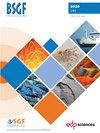Deep crustal structure across a young passive margin from wide-angle and reflection seismic data (The SARDINIA Experiment) – II. Sardinia’s margin
IF 2.6
3区 地球科学
Q2 GEOSCIENCES, MULTIDISCIPLINARY
引用次数: 46
Abstract
Geophysical data acquired on the conjugate margins system of the Gulf of Lion and West Sardinia (GLWS) is unique in its ability to address fundamental questions about rifting (i.e. crustal thinning, the nature of the continent-ocean transition zone, the style of rifting and subsequent evolution, and the connection between deep and surface processes). While the Gulf of Lion (GoL) was the site of several deep seismic experiments, which occurred before the SARDINIA Experiment (ESP and ECORS Experiments in 1981 and 1988 respectively), the crustal structure of the West Sardinia margin remains unknown. This paper describes the first modeling of wide-angle and near-vertical reflection multi-channel seismic (MCS) profiles crossing the West Sardinia margin, in the Mediterranean Sea. The profiles were acquired, together with the exact conjugate of the profiles crossing the GoL, during the SARDINIA experiment in December 2006 with the French R/V L’Atalante. Forward wide-angle modeling of both data sets (wide-angle and multi-channel seismic) confirms that the margin is characterized by three distinct domains following the onshore unthinned, 26 km-thick continental crust : Domain V, where the crust thins from ~26 to 6 km in a width of about 75 km; Domain IV where the basement is characterized by high velocity gradients and lower crustal seismic velocities from 6.8 to 7.25 km/s, which are atypical for either crustal or upper mantle material, and Domain III composed of “atypical” oceanic crust. The structure observed on the West Sardinian margin presents a distribution of seismic velocities that is symmetrical with those observed on the Gulf of Lion’s side, except for the dimension of each domain and with respect to the initiation of seafloor spreading. This result does not support the hypothesis of simple shear mechanism operating along a lithospheric detachment during the formation of the Liguro-Provencal basin.来自广角和反射地震数据(撒丁岛实验)的年轻被动边缘深部地壳结构- 2。撒丁岛的边缘
在狮子湾和西撒丁岛(GLWS)的共轭边缘系统上获得的地球物理数据在解决裂谷作用的基本问题(即地壳变薄,大陆-海洋过渡带的性质,裂谷作用的风格和随后的演化,以及深层和表面过程之间的联系)方面具有独特的能力。虽然在撒丁岛实验(ESP和ECORS分别在1981年和1988年进行)之前,狮子湾(GoL)是几次深地震实验的地点,但西撒丁岛边缘的地壳结构仍然未知。本文首次对地中海西撒丁岛边缘的广角和近垂直反射多道地震剖面进行了建模。在2006年12月与法国R/V L 'Atalante进行的撒丁岛实验中,获得了这些剖面,以及穿越GoL的精确共轭剖面。两组数据的正演广角模拟(广角和多通道地震)证实,该边缘的特征是在陆上未变薄的26公里厚大陆地壳之后有三个不同的区域:V区,地壳变薄约26至6公里,宽度约75公里;ⅳ区基底以高速度梯度和6.8 ~ 7.25 km/s的下地壳地震速度为特征,对地壳和上地幔物质都是非典型;III区由“非典型”洋壳组成。在西撒丁岛边缘观测到的结构呈现出的地震速度分布与在狮子湾一侧观测到的地震速度分布是对称的,除了每个域的尺寸和海底扩张的开始。这一结果不支持利古罗-普罗旺斯盆地形成过程中沿岩石圈拆离作用的简单剪切机制假说。
本文章由计算机程序翻译,如有差异,请以英文原文为准。
求助全文
约1分钟内获得全文
求助全文
来源期刊
CiteScore
5.80
自引率
0.00%
发文量
18
审稿时长
>12 weeks
期刊介绍:
BSGF - Earth Sciences Bulletin publie plusieurs types de contributions :
1. des articles originaux, couvrant tous les champs disciplinaires des Géosciences, à vocation fondamentale mais également à vocation plus appliquée (risques, ressources);
2. des articles de synthèse, faisant le point sur les avancées dans un domaine spécifique des Géosciences, qu''elles soient méthodologiques ou régionales ;
3. des monographies sur la géologie d’une région donnée, assorties d’informations supplémentaires, cartes, coupes, logs, profils sismiques … publiées en ligne en annexe de l’article ;
4. des articles courts de type « express letter » ;
5. des livrets-guides d’excursion (qui suivront le même processus d’examen éditorial que les articles plus classiques) ;
6. des comptes rendus de campagnes à la mer ;
7. des articles de données géodésiques, géophysiques ou géochimiques, pouvant devenir des articles de référence pouvant conduire à des interprétations ultérieures.
BSGF - Earth Sciences Bulletin constitue également un forum pour les discussions entre spécialistes des Sciences de la Terre, de type comment-reply ou autre. Tous les articles publiés, quelle que soit leur forme, seront accessibles sans frais (articles en Open Access) sur le site de la SGF et sur celui de Geosciences World dans la mesure où les auteurs se seront acquittés d’une contribution de (Article Processing Charges – APC) de 300€ pour les membres de la SGF et 500€ pour les non-membres.

 求助内容:
求助内容: 应助结果提醒方式:
应助结果提醒方式:


